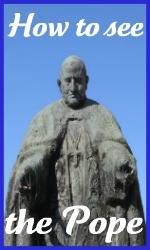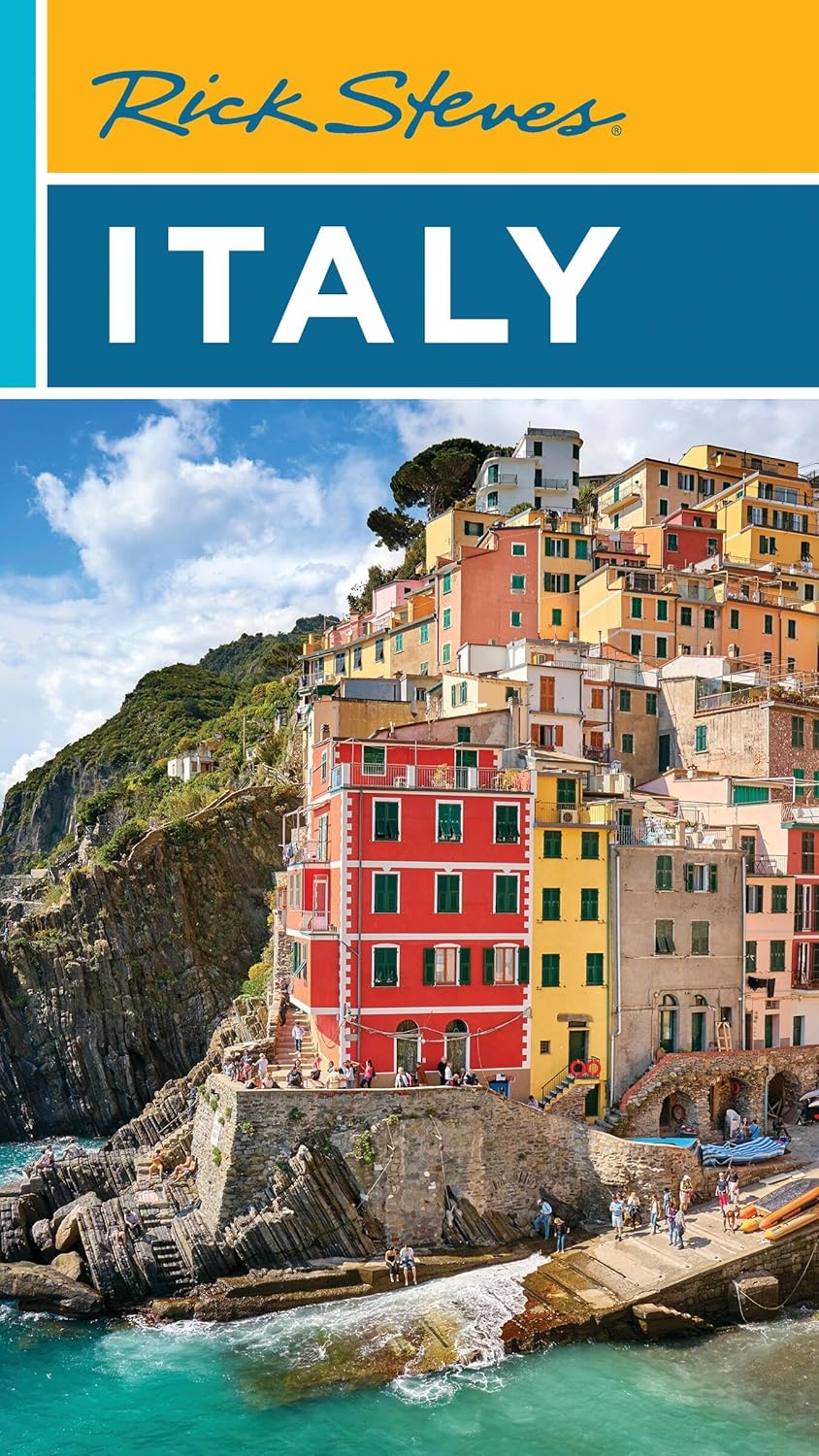The Vatican City: ten facts to help your visit go more smoothly
The Vatican City.
We begin our section of "All
Things Vatican" with ten facts to help you understand what it is,
where it's located and how it works.
This is quite a long page. These are all the sections we cover. If you're particularly interested in just one or two facts, use these links to jump down to that section.
- Vatican City or Holy See? - The differences
- A map of the city
- The flag
- The museums : how to see them
- Is Latin the official language?
- The Swiss Guard
- Coins and stamps
- How the Pope communicates
- Vatican Radio
- Why does the Pope have an observatory?
Vatican City and Holy See: what's the difference?
There's a lot of very confused and confusing information about this on the internet. Here's the real story.
The Holy See is the centre of the Catholic Church which is based within the Vatican City. It has existed for centuries, it spans the world, and unlike the Vatican City it has Ambassadors and is recognised as an important diplomatic entity. It has membership of institutions such as the United Nations and the World Trade Organisation.
The same - but different. The emblems of the two are not identical.
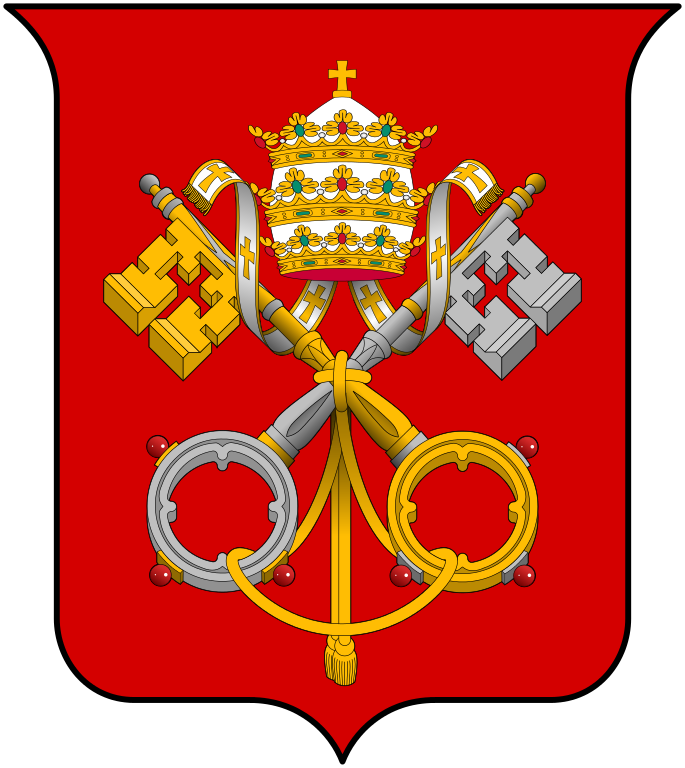 The Holy See emblem - silver key crossed left to right |
 Vatican City emblem - gold key crossed left to right |
The Vatican City came into existence only in 1929. It's a tiny territory on the west bank of the River Tiber in Rome. It's about 3.2 kilometres measured around the outside, 0.44 square kilometres overall - many of them taken up by the Vatican Gardens.
It has a permanent population of approximately 800 people - one of whom is the Pope - although of course thousands more live in Rome and work in the Vatican.
The easiest way of understanding it may be to think of the Vatican City as being the Italian-based capital of the Holy See.
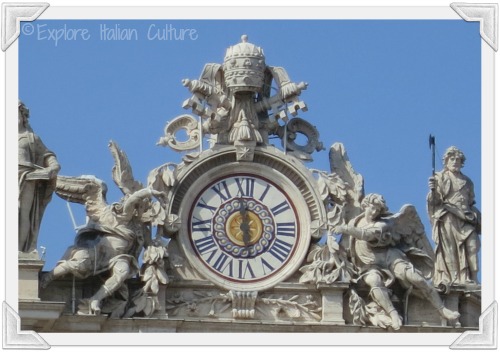 The crossed keys emblem above St Peter's Basilica, Rome
The crossed keys emblem above St Peter's Basilica, RomeAs you walk around Rome, look out for the crossed keys emblems. You'll see them above or outside many churches - and you'll be able to impress your traveling party with your knowledge of what it is!
A map of the Vatican City
You can see from this map that the extent of the Vatican City is roughly guided by St Peter's Basilica, the extensive Vatican Gardens and the museums. Much of this area is off limits to the public entirely, or is available only by ticket.
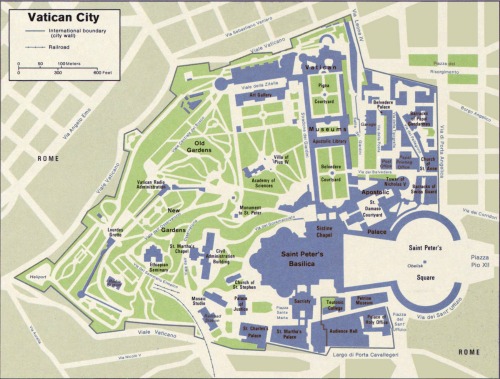
The flag
This is only one of two flags worldwide (the other is the Swiss flag) to be completely square, divided into two equal stripes of yellow, which goes nearest to the flagpole, and white.
No other recognised official flag has this colour combination - heraldic law forbids the use of yellow, representing gold, and white, representing silver, together.

It incorporates the City's own coat of arms, not that of the Holy See - notice the gold key is crossed left to right, as explained above. The keys represent the keys to the kingdom of heaven given by Jesus to St Peter. Above them is the Papal crown or 'tiara' which is not worn by Popes but is simply an heraldic emblem denoting authority.
The flag of the Vatican City was one of the items taken by the astronauts of Apollo 11 to the moon, and that very flag is displayed in the museums together with two small pieces of moon rock.
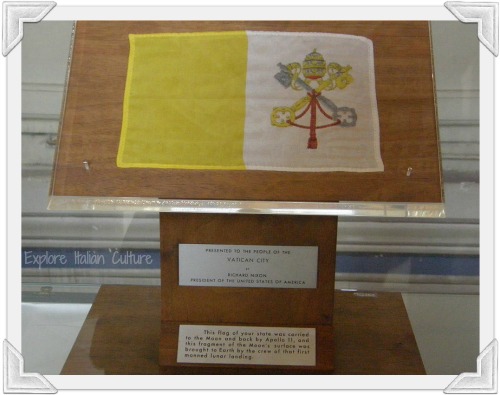 The flag taken to the moon by Apollo 11, displayed in the Vatican Museums
The flag taken to the moon by Apollo 11, displayed in the Vatican MuseumsTalking of the Vatican museums: how to get tickets
The museums within the walls of the Vatican City are one of Rome's prime tourist attractions. They house some of the most important works of art including sculptures and paintings by Leonardo da Vinci, Caravaggio, Raphael and Titian.
The most well known feature, and one which attracts over five million visitors each year, is the Sistine Chapel, with its magnificent ceiling by Michelangelo.
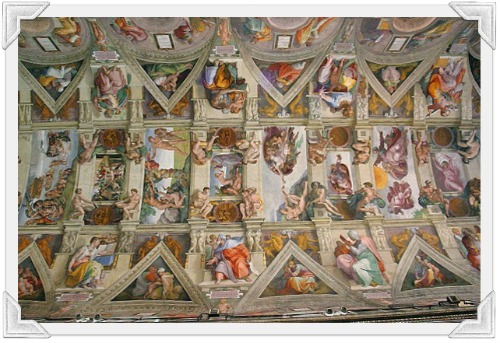 Sistine Chapel ceiling. The public are not allowed to take photographs in the Sistine Chapel; image courtesy of Wikipedia
Sistine Chapel ceiling. The public are not allowed to take photographs in the Sistine Chapel; image courtesy of WikipediaThe Vatican museums have over nine miles of viewing corridors, which even if you spent only one minute before each painting - never mind the sculptures - it would take four years to see every one.
Our advice? Pre book. You can simply buy tickets in advance or you can pre-book a tour with a registered guide (Viator).
Speaking personally, we have always gone with the guided tour. There is simply so much to see, and so much interesting detail, that to visit alone (which we did the second time we visited - the first time we couldn't even get in!) is to miss a lot.
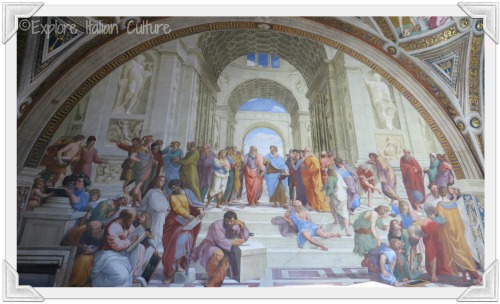
Don't just look - a guide will give you interesting details of all the major works of art and you'll have plenty of time to take stunning pics.
We always use Viator tours in Italy; their guides are local, speak multi languages exceptionally well, and know all the small details that make their tours stand out from the rest.
If you'd like to see our favourite of these Viator tours, use this link.
Does everyone speak Latin?
There are some information sites out there claiming that everyone in the Vatican City speaks Latin. There's no need to brush up on your Latin before you go, though - it's just not true!
There is actually no one official language in the Vatican City, although Italian is the main language spoken both inside the Vatican itself and outside - perhaps not surprisingly, for this is Italy, after all!
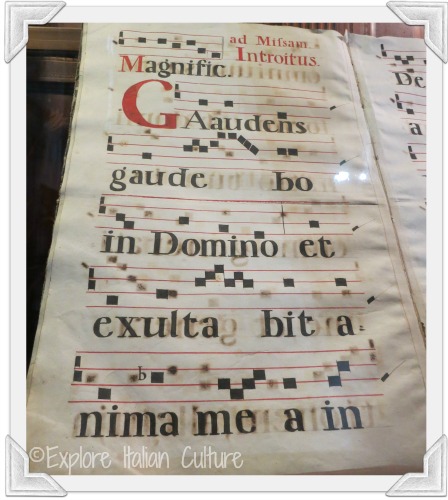
However, because this is one of the main tourist attractions in the whole of Italy, a wide number of different languages are spoken by most people who live and work here, including English, Spanish, Portuguese, German and French.
The mix-up over Latin is probably because Latin is the official language of the Holy See which produces many of its formal decrees and business documents in Latin.
At the time of the resignation of Pope Benedict XVI in 2013, for example, his resignation speech was delivered entirely in Latin - which left many commentators struggling to understand what was happening.
The Swiss Guard
They have a football team and a band, their barracks is situated within the Vatican City and they're one of the great icons for tourist photographs in Rome. It's not a bad life, belonging to the Swiss Guard!
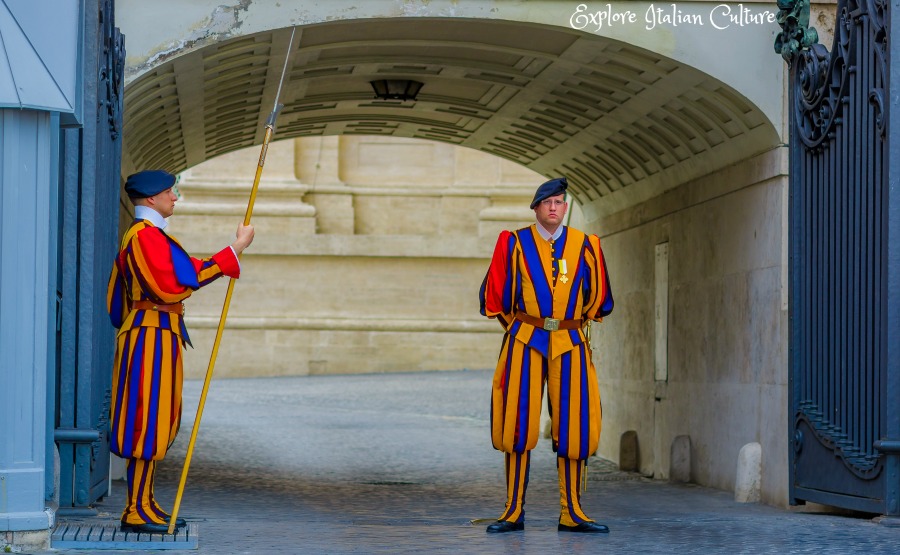 The Swiss Guard at the entrance to their barracks
The Swiss Guard at the entrance to their barracksYou'll see these young men in their brightly coloured uniforms at all entrances to the Vatican, and on any public duties within the Vatican City where the Pope is present. They are, in effect, the official police force of the Vatican City.
The Swiss Guard is a fascinating subject which is impossible to cover properly on this page. For much more detailed information, have a look at our dedicated Swiss Guard page here.
Collectors' Corner: coins and stamps

The Vatican prints its own stamps and mints its own coins which are legal tender throughout all countries which use the Euro coins. The first Vatican Euros were produced in 2002, using the very popular Pope (now Blessed) John Paul II's head.
Released as collectors' sets only, no more than six thousand sets of coins were issued and brought prices of well over one thousand dollars in re-sale.
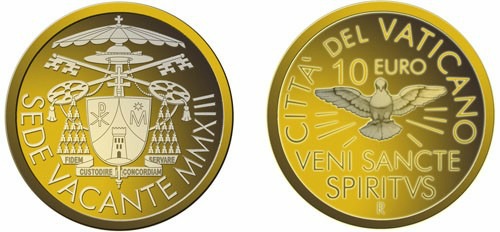
The design of the coins changes with each Pope; in the period between Popes, whilst waiting for the results of the Cardinals' conclave, a special coin is minted showing a 'Vacant See' or 'Sede Vacante'.
This one was distributed in 2013 on the resignation of Pope Benedict XVI and before the inauguration of his successor, Pope Francis. It has the same crossed keys as in the Vatican emblem (see above) but notice the Papal 'tiara' has gone and instead, a Cardinal's hat takes its place.
Communication channels
In recent years, the Papacy has realised and used the full power of the media. The Vatican now has its own:
The online paper is in many different languages and as well as prayers and readings, covers everyday news about the Pope - where he is, what his calendar is, whereabouts he's due to say Mass, when he is holding public audiences and when he is due to go to his summer residence at the beautiful town of Castel Gandolfo. It makes fascinating reading and it's invaluable if you're visiting Rome and want to see him.
There is also now a 'Pope app'! - available free here, which gives similar information about the Pope's whereabouts in a wide variety of languages.
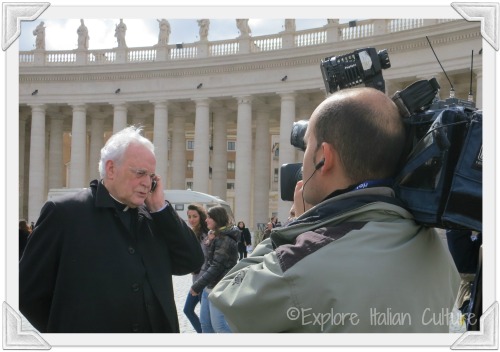 A priest is interviewed for Vatican T.V. in St Peter's Square at the time of the election of Pope Francis.
A priest is interviewed for Vatican T.V. in St Peter's Square at the time of the election of Pope Francis.Vatican Radio
Billed as "The voice of the Church in dialogue with the world", Radio Vatican focuses not only on internal Vatican, but worldwide information seen from a religious perspective.
You'll be able to hear the Pope's sermons and addresses during Mass and public audiences; readings and reflections; and the rosary or 'Stations of the Cross'. There are also downloadable podcasts featuring the Pope, and again it gives the Pope's agenda for the next several days.
It's a useful resource not only if you're visiting Rome but if you're a Catholic who perhaps can't get to Rome or to Mass, but would still like to hear the Pope in person.
And finally - the Vatican Observatory
This isn't actually based in Rome but in the Pope's summer residence at the nearby town of Castel Gandolfo, which is still classed as part of the Vatican city.
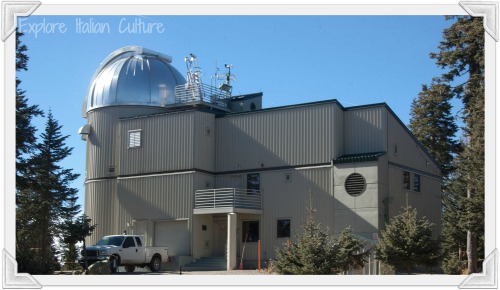
Partnered with the Steward Observatory at the University of Arizona, USA, it's described as a "bridge between Church and science".
It has a number of very powerful telescopes and astronomers from every continent - all of them priests - whose job it is to embrace "true and solid science" in every field of astronomy.
If you're interested in further information have a look at their website here.
More information about the Pope
Please be aware - some websites will charge you for tickets to the Pope's weekly public audience. The tickets are actually free of charge, although getting them is a bit of a complicated process.
If you're visiting Rome and you'd like to see the Pope but aren't sure how, click on this picture to go to a separate page of information. Included is the low-down on how to apply for tickets - but make sure you do it well in advance of your visit, for numbers are limited and it's always popular.

